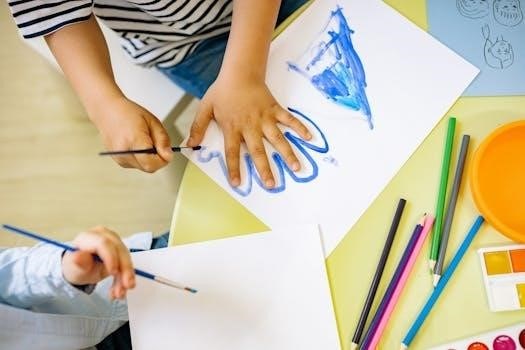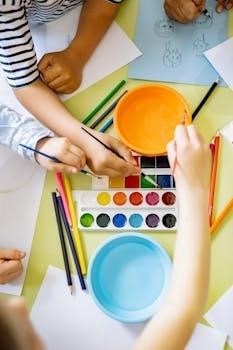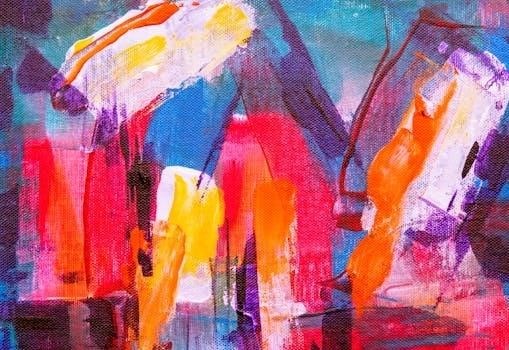watercolour painting pdf
Unleash your inner artist! Download our FREE watercolour painting PDF and create adorable cat masterpieces. Easy steps, stunning results!
Watercolour Painting PDF⁚ A Comprehensive Guide
Embark on a creative journey with our comprehensive guide to watercolour painting PDFs. This collection offers invaluable resources for artists of all levels. It includes tutorials and techniques, as well as downloadable PDFs. Unlock your artistic potential and explore the world of watercolour today!
Watercolour painting, an absorbing and meditative art form, invites artists to explore its translucent beauty. Perfect for beginners, watercolour offers a gentle entry into the world of painting. Start by learning fundamental techniques, understanding essential supplies, and experimenting with colour mixing.
Free watercolour tutorials and downloadable PDFs provide a solid foundation for beginners eager to explore and fall in love with this medium. Discover resources that demystify watercolour painting and offer guidance on getting started. These resources help unlock the secrets to creating beautiful artwork with watercolour.
Watercolor painting involves specific papers, brushes, and paints tailored for the medium. Explore basic techniques like washes, gradients, lifting, and dry brushing. With practice, aspiring artists can master these techniques and start creating stunning watercolour pieces. Learn how to paint skies, trees, flowers, and landscapes through step-by-step instructions.
Watercolour painting is a rewarding and accessible art form that offers endless opportunities for creative expression. Whether starting from scratch or aiming to expand your skills, watercolour provides a versatile and enjoyable artistic journey.
Essential Watercolour Supplies for Beginners
Starting watercolour painting requires a few key supplies to ensure a successful and enjoyable experience. First, invest in a set of watercolour paints, either pans or tubes, to provide a range of colours for mixing and experimenting.
Next, acquire watercolour brushes in various sizes and shapes. Round brushes are versatile for detail work, while flat brushes are ideal for washes. Watercolour paper is crucial. Opt for a heavyweight paper (140lb/300gsm) to prevent buckling and allow for multiple layers of paint.
A palette is essential for mixing colours. A plastic or ceramic palette with wells is perfect for this purpose. A water container is necessary for cleaning brushes and diluting paints. Have a soft cloth or paper towels on hand to blot excess water and clean brushes.
Additional helpful supplies include masking tape to secure paper, a pencil for sketching, and an eraser for corrections. With these essential supplies, beginners can confidently explore the world of watercolour painting and start creating beautiful artwork.
Basic Watercolour Techniques
Mastering basic watercolour techniques is essential for any beginner. One fundamental technique is the “wash,” which involves applying a diluted layer of paint to create a smooth, even tone. Practice creating flat washes and graduated washes, where the colour gradually transitions from dark to light.
Another important technique is “wet-on-wet,” where paint is applied to a wet surface, allowing colours to blend and create soft, dreamy effects. Experiment with different amounts of water to control the flow and diffusion of the paint.
“Dry brush” is another technique that involves using a brush with very little water to create textured, scratchy effects; This technique is perfect for adding details and creating the illusion of rough surfaces.
Lifting paint is a useful technique for correcting mistakes or creating highlights. Use a clean, damp brush or a paper towel to lift the paint from the paper.

Layering is a technique that involves applying multiple layers of paint to build up depth and intensity of colour. Allow each layer to dry completely before applying the next to prevent muddiness. By practicing these basic techniques, you can gain confidence and control over your watercolour painting.
Mixing Watercolour Paints⁚ A Beginner’s Guide

Understanding colour mixing is crucial for watercolour painting. Start with a limited palette of primary colours⁚ red, yellow, and blue. These colours can be mixed to create a wide range of secondary and tertiary colours.
When mixing, begin with a small amount of pigment and gradually add more until you achieve the desired colour. Keep a colour chart of the colours you mix to easily replicate them later. It will help you remember the right proportions.
Understanding colour theory will significantly improve your mixing skills. Learn about complementary colours, which are opposite each other on the colour wheel and can be mixed to create neutral tones. This is also important to master the art of mixing browns and grays.
Experiment with different ratios of water to paint to control the intensity and transparency of the colours. Remember that watercolour paints dry lighter than they appear when wet, so adjust accordingly.
Clean your brush thoroughly between mixing colours to prevent contamination. A clean brush will prevent you from creating unintended colours. With practice, you will develop a feel for mixing colours and be able to create the perfect shades for your paintings.
Free Watercolour Tutorials for Beginners
Embarking on your watercolour journey? Discover a treasure trove of free watercolour tutorials designed specifically for beginners. These tutorials provide step-by-step guidance on essential techniques and foundational skills.
Explore online platforms such as YouTube and art blogs for numerous free tutorials. Many artists share their expertise, offering valuable insights into brushwork, colour mixing, and composition. These resources can kickstart your watercolour adventure.
Look for tutorials that cover basic techniques like washes, layering, and lifting. Practice these techniques to build a solid foundation. Start with simple subjects such as leaves, flowers, and landscapes to hone your skills.
Download free PDF guides that provide written instructions and visual aids. These guides often include exercises to reinforce your learning. Use them as a reference to understand the core concepts of watercolour painting.
Participate in online communities and forums to connect with other beginners and experienced artists. Seek feedback on your work and learn from their experiences. Remember, practice is key to improving your watercolour skills.
These free resources offer a fantastic starting point. Enjoy the process of learning and experimenting with watercolour!
Advanced Watercolour Techniques
Ready to elevate your watercolour skills? Delve into advanced techniques that will add depth, texture, and complexity to your paintings. Mastering these techniques will set your art apart.
Explore glazing, a technique that involves layering thin washes of colour to create luminous effects. Learn to control the transparency of your paints to build subtle gradations and rich tones. Practice patience, as glazing requires multiple layers and drying time.
Discover dry brushing, a technique that creates textured surfaces by dragging a semi-dry brush across the paper. Experiment with different brush types and paper textures to achieve various effects. Use dry brushing to depict rough surfaces, such as rocks or tree bark.
Master the art of lifting, which involves removing paint from the paper to create highlights or correct mistakes. Experiment with different tools, such as brushes, sponges, or paper towels. Use lifting to create a sense of light and atmosphere.
Explore masking techniques, using masking fluid or tape to protect certain areas of your painting; Apply masks to create sharp edges or intricate patterns. Experiment with masking to add detail and precision to your work.
These advanced techniques require practice and experimentation. Don’t be afraid to push your boundaries and explore new approaches. Embrace the challenges and enjoy the process of refining your watercolour skills.
Watercolour Painting with Pen and Ink
Combine the delicate beauty of watercolour with the bold definition of pen and ink to create captivating artwork. This mixed-media approach offers unique opportunities for expression.
Begin by sketching your subject with a waterproof ink pen. Choose a pen with a fine nib for detailed linework, or a broader nib for bolder strokes. Experiment with different ink colours to add visual interest.
Allow the ink to dry completely before applying watercolour washes. Use a light touch with your brush to avoid smearing the ink. Build up layers of colour gradually to create depth and dimension.
Explore different watercolour techniques, such as wet-on-wet or dry brushing, to complement the ink lines. Consider using complementary colours to create contrast and visual harmony.
Experiment with different styles of linework, from delicate cross-hatching to bold outlines. Use ink to add texture and detail to your painting. Consider using a dip pen for a more traditional look.
Incorporate watercolour washes to soften the ink lines or create a sense of atmosphere. Use watercolour to add colour and vibrancy to your drawing. Experiment with different watercolour papers to achieve various effects.
Watercolour and ink can enhance each other, resulting in stunning pieces of art. Don’t be afraid to experiment and develop your own style.
Watercolour Painting with Mixed Media
Extend your artistic horizons by incorporating mixed media into your watercolour paintings. This approach opens up a world of creative possibilities, allowing you to add texture, depth, and unique visual elements to your artwork.
Consider incorporating materials like collage elements, acrylic inks, gesso, or even fabric scraps to create interesting surface textures. Experiment with different types of paper, such as textured watercolour paper or even handmade paper, to add a tactile dimension to your work.
Gesso can be used to create textured grounds for your watercolour paints, allowing you to build up layers of colour and create interesting effects. Acrylic inks can be used to add bold, vibrant accents to your paintings.
Collage elements, such as tissue paper or old book pages, can be incorporated to add visual interest and create a sense of depth. Fabric scraps can be used to add texture and create unique patterns.
Experiment with different techniques, such as layering, masking, and resist methods, to create complex and multi-layered compositions. Don’t be afraid to experiment and push the boundaries of traditional watercolour painting.
Mixed media can bring a unique and unexpected twist to your watercolour art, allowing you to express yourself in new and exciting ways. The possibilities are endless, so let your imagination run wild!
Painting Skies in Watercolour
Mastering watercolour skies is essential for creating captivating landscapes. Skies set the mood and provide context for your entire painting. Achieving realistic and expressive skies involves understanding colour mixing, value control, and brushwork techniques.
Begin by diluting your watercolour paints with plenty of water. This creates a fluid wash that allows for smooth transitions and soft edges. Use a large, soft brush to apply the wash to your paper, working quickly to avoid hard lines.
For a basic sky, consider using a combination of blues, such as cerulean blue and ultramarine blue, along with a touch of alizarin crimson for warmth. Experiment with different colour combinations to create a variety of sky effects, such as sunrises, sunsets, and stormy skies.
To create depth and dimension, layer your washes, allowing each layer to dry slightly before applying the next. This technique allows you to build up subtle variations in colour and value, creating a more realistic and atmospheric effect.
Clouds can be created by lifting paint from the paper with a clean, damp brush or sponge. This technique creates soft, fluffy shapes that mimic the appearance of clouds.
Remember to pay attention to the light source and cast shadows accordingly. This adds realism and depth to your sky, making it more believable.
Painting Trees and Landscapes in Watercolour
Embark on a scenic journey by painting trees and landscapes in watercolour. This section offers techniques to capture the beauty of nature; Start by sketching the basic shapes of your landscape. This will serve as a guide for your watercolour application.
For trees, use a variety of greens, browns, and yellows to create realistic foliage. Experiment with wet-on-wet and dry brush techniques to achieve different textures. Wet-on-wet creates soft, blended effects, while dry brush adds crisp details.
Layer your colours to build depth and dimension. Start with light washes and gradually add darker values to create shadows and highlights. This will make your trees appear more three-dimensional.
When painting landscapes, pay attention to atmospheric perspective. Objects in the distance should appear lighter in colour and less detailed than those in the foreground. This creates a sense of depth and distance.
Use a variety of brushstrokes to depict different textures in your landscape. Short, choppy strokes can represent grass and foliage, while long, flowing strokes can depict water or sky.
Don’t be afraid to experiment with different techniques and colour combinations to find your own unique style. The key is to practice and observe nature closely.
Painting Flowers in Watercolour
Delve into the delicate art of painting flowers in watercolour. This section offers insights into capturing the beauty of floral subjects. Begin by observing the flower’s unique structure and form. Pay attention to the petal shapes, stem angles, and overall composition.
Sketch a light outline of the flower on your watercolour paper. This will serve as a guide for applying your paints. Use a soft pencil to avoid making dark, permanent lines.
Start with light washes of colour to create a base layer. Gradually add darker values to create shadows and highlights. This will give your flower depth and dimension.
Experiment with different watercolour techniques to achieve various effects. Wet-on-wet technique is ideal for soft, blended petals, while dry brush technique can create textured details.
Use a variety of brushstrokes to capture the delicate details of the flower. Thin, precise strokes can define petal edges, while broader strokes can fill in larger areas.

Mix your colours carefully to achieve realistic and vibrant hues. Observe the flower closely to identify subtle colour variations. Don’t be afraid to experiment with unusual colour combinations to add your personal touch.
Consider adding details like water droplets or background elements to enhance your painting. These additions can create a sense of realism and visual interest.
Free Watercolour Resources and eBooks
Unlock a treasure trove of knowledge with these free watercolour resources and eBooks! Whether you’re a beginner or seasoned artist, these materials offer valuable insights and inspiration. Explore a variety of topics, from basic techniques to advanced concepts.

Discover eBooks covering colour theory, brushwork, and composition. Learn how to mix colours effectively, create stunning washes, and achieve realistic textures. These eBooks provide step-by-step guidance and practical exercises to enhance your skills.
Access free online tutorials and video lessons that demonstrate various watercolour techniques. Watch experienced artists create beautiful paintings and learn their secrets. These visual resources offer a dynamic and engaging way to learn.
Take advantage of downloadable PDF guides that provide concise summaries of key concepts. These guides are perfect for quick reference and review. Keep them handy in your studio for easy access to essential information.
Explore websites and online communities dedicated to watercolour painting. Connect with fellow artists, share your work, and receive feedback. These platforms offer a supportive environment for learning and growth.
Many art supply companies offer free resources on their websites, including tutorials, colour charts, and product guides. These resources can help you choose the right materials and get the most out of your supplies.
Don’t miss out on these incredible free resources that can help you master the art of watercolour painting!

